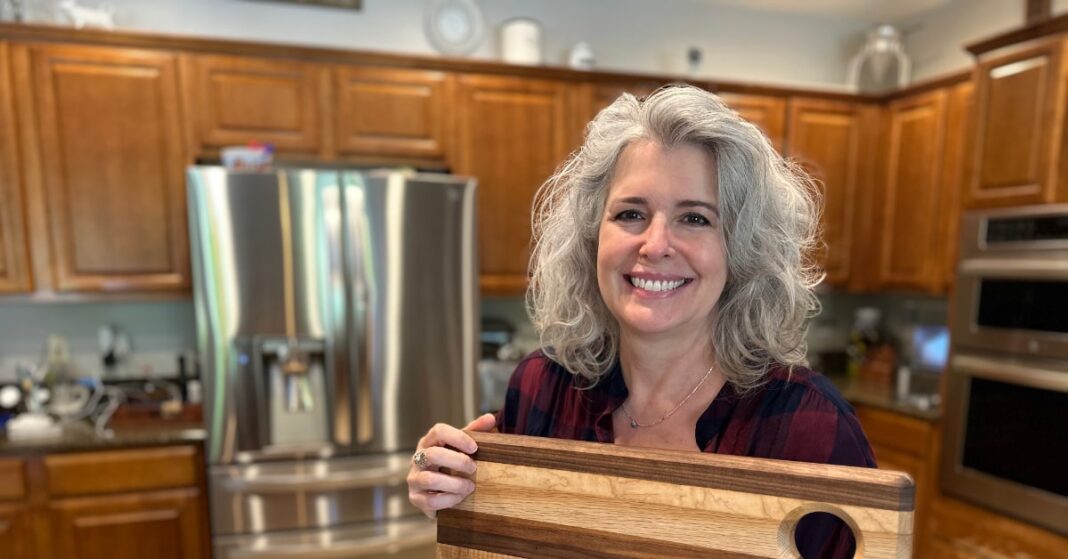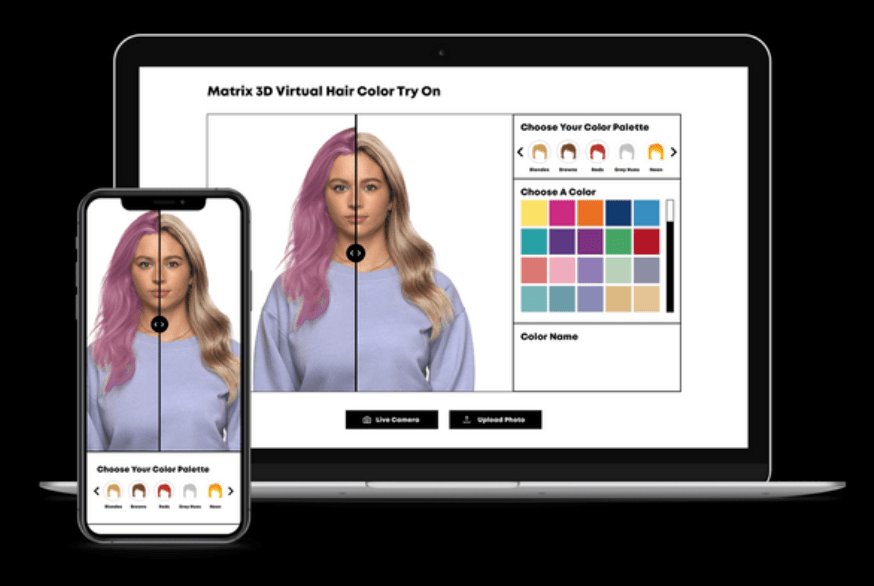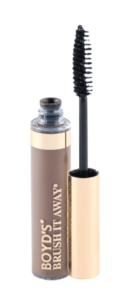One day I was smoothing my hair with a flat iron and I saw it — my first gray hair. The short and wiry strand stood straight up like a beacon. Did I rejoice in this discovery that was signaling a new era? Did I embrace the gray as a badge of honor?
No. I plucked the sucker out.
Most of us find our first gray hair well before 50. The sighting often occurs during the childbearing years. During that time, many of us pluck and dye to keep the gray away.
It may be fun to try different hair colors in our younger years; but as the gray increases, the fun decreases. At some point we end up embracing the gray simply for convenience.
According to a survey conducted by KatieGoesPlatinum.com, almost 40% of us decide to go gray in our 50s.
By the time we reach our 70s, only 30% of women are still covering the gray with hair dye.
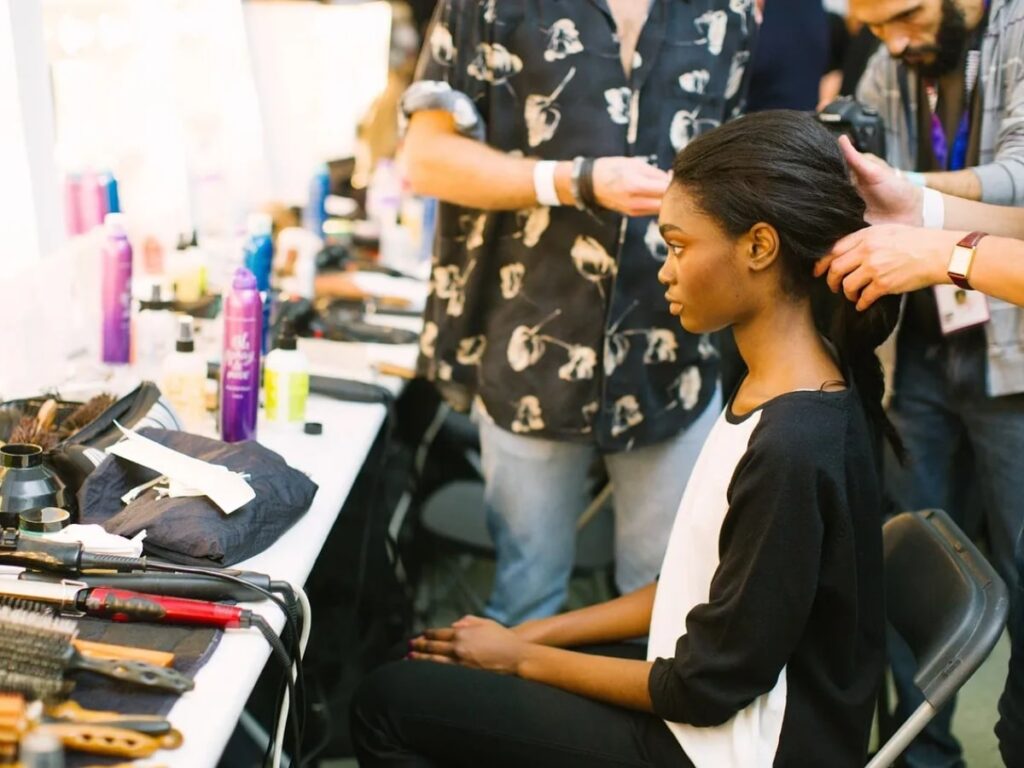
One woman’s story
Julie had very dark, almost black hair growing up. She was 16 when the first gray hair appeared and 23 when she started covering the gray with hair dye. At 25, professional treatments became part of her routine.
In her 30’s and 40’s, Julie learned to color her own hair and was retouching her new growth every three weeks. Her husband would help with the spots that were difficult to reach. “I was sick of it. I toyed with the idea of letting my natural hair grow out, but the regrowth was so obvious. I just hated it.”
In her 50’s, Julie’s view shifted. “I started noticing 20-year-old girls, who, instead of having platinum blonde hair done at a salon, had silvery white hair instead.
Suddenly, my natural hair color was on trend!
She asked her stylist to strip out the dye. “Absolutely not!” was the response. Turning her dark hair to white would cause severe damage.

COVID-19 was the catalyst for Julie’s eventual transition.
“Suddenly I was at home, with no access to hair color, but also no one to see me except my immediate family, who were all super aware of my natural hair color.”
She let the roots grow and cut it short. “I just gritted my teeth at the contrast between the dark and the light. I may have been the only person on earth who felt the COVID shutdown didn’t last long enough!” she laughs.
“Sometimes it’s still jarring to catch a reflection of myself in a store window. I used to wonder who that old lady was! And I think that was the hardest part of the entire situation.
I didn’t want to look old.
Julie no longer thinks she looks like an old lady. “I get a lot more random compliments from complete strangers with my natural hair… the McDonald’s drive-thru guy, about mid-30’s…a 10-year-old girl at church…a 20-something young woman with purple hair and facial piercings at Walmart…a young woman at the doctor’s office.”
So should I color my gray hair?
How do you determine when the time is right? Here is a guide to help you figure it out, starting with the reasons for both choices:
Reasons for coloring your gray hair
- Golden blond, spicy red, deep brown, or really any color other than gray, makes you look and feel younger. I’m not ready to be offered the senior discount quite yet.
- Hair dye makes hair feel thicker. At a time when hair may be thinning a little (or a lot), adding some thickness is very appealing. You may dye your hair just for this reason alone.
- You may not like the look of gray hair or don’t think you will like the way you look with gray hair.
Reasons for going gray
- Going gray is a new adventure! In recent years it’s become a trendy hair color. At some point, no one is fooled about your age anyway.
- After the transition period, maintenance becomes cheaper and easier. No running to the salon or drugstore for touch-ups every two weeks.
- Repeatedly applying chemicals can really impact the health and strength of your hair.
A few more things to consider
On average, hair grows about half an inch per month, totaling around six inches per year. Individual growth rates may vary depending on factors such as genetics, age, and overall health.
If you decide to go gray, there will be a transition period.
The transition period can be long and hard. It’s not uncommon for a woman to make two or three attempts before fully giving up the dye. Julie almost quit multiple times and considered traveling to another state for an expert on hair transitioning.
When your hair changes to gray, your makeup and clothing may need to change too.
Colors that previously looked great may be too intense or strong. You might want to take the money saved at the salon and invest in a makeover and some new wardrobe pieces.
Still not sure? Take gray for a test drive
Curious to know what you will look like once going gray? Try an app or website that lets you see yourself with different shades of color. There are several free apps available.
Or consider being all gray for a day. You can test the waters with a 1-day hair color spray.
6 ways to transition to natural gray
Women have been struggling with the question “should I color my gray hair?” for a long time. And in that time, we’ve come up with a number of options.
- Gradual growing it out
One of the simplest techniques for transitioning to natural gray is to allow your hair to grow out gradually. As your roots begin to grow in, they will reveal your natural gray color over time.
This method requires patience.
It may take several months to a year for your hair to fully transition. To minimize the contrast between the old color and the emerging gray, consider getting regular trims to remove the colored ends gradually.
- Highlights or lowlights
Another option for transitioning to natural gray is to incorporate highlights or lowlights into your hair. This can soften the grow-out line.
By strategically adding lighter or darker tones to your hair, you can create a blended look that camouflages the gray as it grows in.
Highlights add dimension and brightness, while lowlights add depth and richness to your hair color. Work with a professional hairstylist to determine the best placement and shades to achieve a natural-looking transition.
- Balayage or ombre
Balayage and ombre are hair coloring techniques that involve hand-painting color onto sections of the hair for a subtle, gradient effect. These techniques can be adapted to facilitate the transition to natural gray by blending the existing color with the emerging gray strands.
By gradually lightening the ends of your hair, you can create a seamless transition that mimics the natural progression of gray hair. Consult with a skilled stylist who specializes in balayage or ombre to achieve a customized look that complements your skin tone and hair texture.
Read Balayage vs. traditional highlights from the Better Not Younger blog to learn how suitable each is for covering gray hair.
- Color correction
If you’ve been coloring your hair for some time and want to transition to natural gray more quickly, color correction may be necessary.
This involves removing or lightening the artificial color from your hair to reveal the underlying gray.
Color correction can be a complex process and is best performed by a professional hairstylist who has experience with advanced coloring techniques.
They can assess your current hair color and develop a customized plan to safely transition to natural gray while preserving the health and integrity of your hair.
- Gray hair dye
This may be the last time you need to dye your hair. Consult with a professional to evaluate your hair to determine if this is a good option. Your stylist can pick the best shade of gray.
- Cut short or shave
If you don’t want to use chemicals and you don’t want to wait, a short cut or shave will speed up the transition process. Shaving is the most dramatic choice and is for the boldest of the bold.
This is the fastest way to transition by eliminating all traces of your “before” hair.
But if you are not ready to take the leap, there are several ways to hide the gray.
Color techniques, from temporary to permanent
Decided you definitely want to color your gray hair? You have many options, ranging from temporary to relatively permanent.
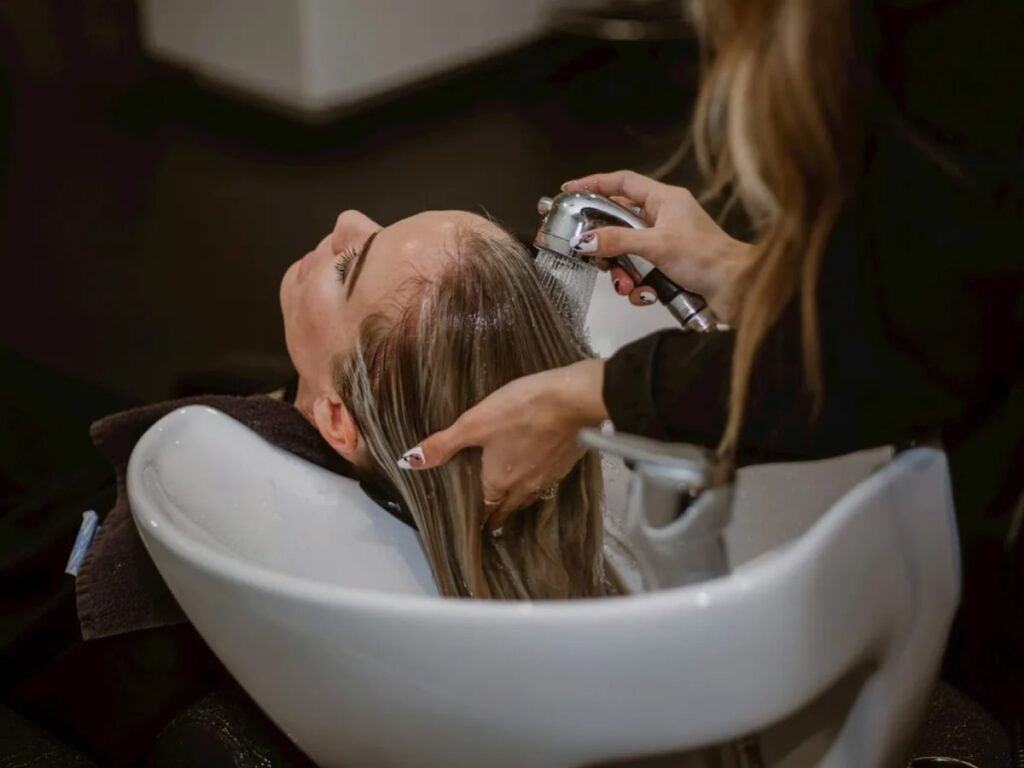
Temporary solutions
Let’s start with the easier and (often) less expensive options for hiding those grays.
Root touch-up sprays
Root touch-up sprays offer a quick and easy way to cover gray roots temporarily. Simply spray the product onto the roots and blend for instant coverage.
These sprays typically wash out with shampoo, making them a convenient option for touch-ups between salon visits.
Powder root concealers
Similar to root touch-up sprays, powder root concealers provide temporary coverage for gray roots. The powder adheres to the hair, camouflaging gray strands until the next shampoo.
They come in various shades to match different hair colors and are often applied with a brush or sponge applicator.
Temporary Hair Mascara
Hair mascara is a temporary coloring product that resembles mascara for eyelashes. It comes in a tube with a wand applicator and can be brushed onto gray hairs for instant coverage.
Hair mascara washes out easily with shampoo, making it ideal for temporary touch-ups.
Semi-permanent solutions
The options listed below fall in the middle ground. As such, they may last a bit longer than the temporary solutions.
Semi-permanent hair color
Semi-permanent hair color is a gentler alternative to permanent dye and gradually fades over time. It typically lasts for several weeks before requiring a touch-up.
Semi-permanent color blends with the natural hair color, resulting in a subtle change that fades naturally without obvious roots.
Color-depositing conditioners
Color-depositing conditioners are hair care products infused with pigments that enhance or refresh hair color. They can be used to tone down gray hair or maintain the vibrancy of colored hair between salon visits.
These conditioners are applied like regular conditioners and provide temporary color that washes out gradually.
Henna
Henna is a natural dye derived from the leaves of the henna plant.
Henna has been used for centuries to cover gray hair.
Henna deposits color onto the hair shaft, resulting in rich, long-lasting color.
While henna is considered a safe and natural option, it can be messy to apply and may require multiple applications to achieve the desired shade.
Permanent solutions
These options tend to last longer, but also often cost more.
Permanent hair dye
Permanent hair dye is the most popular and long-lasting option for covering gray hair. It penetrates the hair shaft and permanently alters the hair’s color.
Permanent dyes come in a wide range of shades and formulations, including:
- – Traditional liquid dyes
- – Foam dyes
- – Cream dyes
They provide full coverage for gray hair and require regular touch-ups as the roots grow out.
Professional salon treatments
Professional salon treatments, such as highlights, lowlights, and balayage, offer customized solutions for covering gray hair.
These techniques involve strategically placing color throughout the hair to create dimension and blend away gray strands.
Salon treatments can be tailored to individual preferences and provide natural-looking results that complement the client’s skin tone and lifestyle.
To color or not to color those grays
There are many options out there, from temporary fixes like root touch-up sprays and permanent hair dye to transitioning techniques like balayage or ombre.
The choice comes down to what makes you feel confident and comfortable in your own skin.
If you are still unsure, you could try joining a Facebook group full of women going through the same process.
If this is all too much, there is always a hat.
Frequently asked questions (FAQs)
Still have questions? The answers may be here.
When should you stop coloring gray hair?
Unfortunately there’s no single answer to this question, as it is such a personal decision.
Some women will like how they look as their hair changes with the natural hormonal shifts that take place as we age (read more about the effects of hormonal changes in your 50s here).
Depending on the hair color you were born with, this may happen as early as your 20s or 30s. And it might not actually go gray at first. You may notice a subtle fading of your natural color.
If you don’t like your current hair color, consider downloading one of the free apps linked above to see how you might look with various hair colors. Or you can use a 1-day hair color spray from the drugstore or pharmacy to test out a new color
Is it better to go darker or lighter with gray hair?
You can cover your gray hair by coloring all your hair — either at home or at a salon.
The problem with this is that you will have gray roots that will be very obvious in a matter of weeks. So you will need to dye or use root touch-up sprays or powder root concealers between dyes.
if your hair is naturally on the lighter side, going with highlights may extend the time between at-home or salon treatments. As the gray regrows, it will be hidden among the highlights and less noticeable.
If your hair is dark, a brunette shade with a mix of undertones will provide a beautiful dimensional result. It may also make the regrowth of gray hair look less noticeable than using a single highly-saturated shade.
For those of you who are dying their own hair, look for an ammonia-free hair dye to avoid thinning or damage.
Is it good to color gray hair?
The simple answer to this is, if it makes you feel good then yes it’s good to color your gray hair.
But depending on how much heat and environmental stress your hair has been exposed to, coloring your hair may or may not be a good idea. The only way to know for sure is to ask a professional hair colorist.
While you may think that gray hair is more vulnerable than your natural hair, the opposite is true. “The more pigment your hair has, the more sensitive it is to stress, nutrition, the use of chemical products, and smoking,” explains Hitomi Ikeda, a master colorist at Rob Peetoom Salon Williamsburg.
Remember that all dye-treated hair requires lots of moisture to maintain its vibrancy. Deep conditioners, leave-in conditioners, or hot oil treatments can help.
Does coloring your hair gray make you look older?
It depends on the color you choose. Some women find that their natural color no longer looks natural on them. This may be because as your hair loses pigment, so does your skin.
Again, the best option here is to ask a professional to help you choose a shade or shades.


